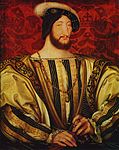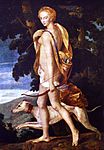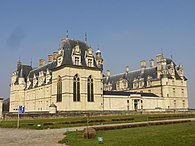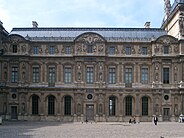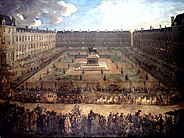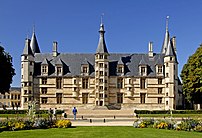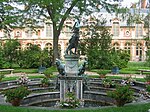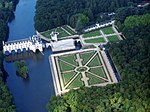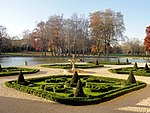French Renaissance
| Renaissance |
|---|
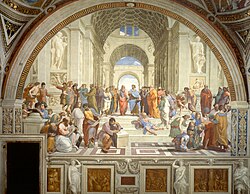 |
| Aspects |
| Regions |
| History and study |
The French Renaissance was the cultural and artistic movement in France between the 15th and early 17th centuries. The period is associated with the pan-European[citation needed] Renaissance, a word first used by the French historian Jules Michelet to define the artistic and cultural "rebirth" of Europe.
Notable developments during the French Renaissance include the spread of humanism, early exploration of the "New World" (as New France by Giovanni da Verrazzano and Jacques Cartier); the development of new techniques and artistic forms in the fields of printing, architecture, painting, sculpture, music, the sciences and literature; and the elaboration of new codes of sociability, etiquette and discourse.
The French Renaissance traditionally extends from (roughly) the 1494 French invasion of Italy during the reign of Charles VIII until the 1610 death of Henry IV, with an apex during the 1515–1559 reigns of Francis I and Henry II.
This chronology notwithstanding, certain artistic, technological or literary developments associated with the Renaissance arrived in France earlier (for example, by way of the Burgundy court or the papal court in Avignon); however, the Black Death of the 14th century and the Hundred Years' War kept France economically and politically weak until the late 15th century.
The word "Renaissance"
The word Renaissance is a French word, whose literal translation into English is "Rebirth". The term was first used and defined[1] by French historian Jules Michelet in his 1855 work Histoire de France (History of France).[2] Jules Michelet defined the 16th-century Renaissance in France as a period in Europe's cultural history that represented a break from the Middle Ages, creating a modern understanding of humanity and its place in the world.[3] As a French citizen and historian, Michelet also claimed the Renaissance as a French movement.[4]
Art
| French art history |
|---|
| Historical periods |
| French artists |
| Thematic |
| Movements |
| See also |
|
In the late 15th century, the French invasion of Italy and the proximity of the vibrant Burgundy court (with its Flemish connections) brought the French into contact with the goods, paintings, and the creative spirit of the Northern and Italian Renaissance, and the initial artistic changes in France were often carried out by Italian and Flemish artists, such as Jean Clouet and his son François Clouet and the Italians Rosso Fiorentino, Francesco Primaticcio and Niccolò dell'Abbate of the first School of Fontainebleau (from 1531).
In 1516,
The art of the period from Francis I through
There are a number of French artists in this period including the painter Jean Fouquet of Tours (who achieved realistic portraits and remarkable illuminated manuscripts) and the sculptors Jean Goujon and Germain Pilon.
Late Mannerism and early Baroque
Henry IV invited the artists
Outside France, working for the dukes of Lorraine, one finds a very different late mannerist style in the artists Jacques Bellange, Claude Deruet and Jacques Callot. Having little contact with the French artists of the period, they developed a heightened, extreme, and often erotic mannerism (including night scenes and nightmare images), and excellent skill in etching.
-
Eve, First Pandora by Jean Cousin the Elder (c. 1550).
-
Ligier Richier, Lamentation of Christ, Church of St. Étienne, Saint-Mihiel
-
Diane the Huntress, School of Fontainebleau (1550–60) (Louvre).
-
Lady in her Bath by François Clouet(c. 1570) (National Gallery, Washington).
-
Monument containing the heart of Henry II of France by Germain Pilon.
-
Portrait of Gabrielle d'Estrées and Duchess of Villars, School of Fontainebleau, c. 1594
-
Allégorie de la Peinture et de la Sculpture, Ambroise Dubois
-
Hyacinthe and Climène at Their Morning Toilet (detail) by Toussaint Dubreuil, a scene from Pierre de Ronsard's Franciade (c. 1602) (Louvre)
Architecture
One of the greatest accomplishments of the French Renaissance was the construction of the Châteaux of the Loire Valley: no longer conceived of as fortresses, these pleasure palaces took advantage of the richness of the rivers and lands of the Loire region and they show remarkable architectural skill.
The old
The ascension of
Garden
French Renaissance gardens were characterized by symmetrical and geometric planting beds or parterres; plants in pots; paths of gravel and sand; terraces; stairways and ramps; moving water in the form of canals, cascades and monumental fountains, and extensive use of artificial grottes, labyrinths and statues of mythological figures. They became an extension of the chateaux that they surrounded, and were designed to illustrate the Renaissance ideals of measure and proportion.
-
Gardens of the Château de Villandry
-
Diane de Poitiers' garden from the Château de Chenonceau
-
Fountain of Diana, in the gardens of theChâteau de Fontainebleau
-
Aerial view of Château de Chenonceau and its gardens
-
Jardin de la volière at Château de Chantilly
Literature
Music

The most renowned composer in Europe,
By far the most significant contribution of France to music in the Renaissance period was the
The era of religious wars had a profound effect on music in France. Influenced by
See also
- Early modern France
- Late Renaissance
- Music history of France
References
- ISBN 978-0-500-20008-7.
- ^ Michelet, Jules (1847). History of France. Translated by Smith, G. H. D. Appleton & Company.
- ^ Brotton, Jerry (2002). The Renaissance Bazaar. Oxford University Press. pp. 21–22.
- ISBN 0-19-280163-5..
- ^ Tanaka 1992, p. 90
- Tanaka, Hidemichi (1992), "Leonardo da Vinci, Architect of Chambord?", Artibus et Historiae, 13 (25): 85–102, JSTOR 1483458
Further reading
- ISBN 0-300-05314-2.
- Chastel, André. French Art Vol II: The Renaissance. OL 8841209M.
- Chastel, André (1996). French Art Vol III: The Ancient Régime. Flammarion. OL 8841223M.
- Hampton, Timothy (2003). Literature and Nation in the Sixteenth Century: Inventing Renaissance France.
- Holt, Mack P. (2002). Renaissance and Reformation France: 1500-1648. The Short Oxford History of France. OL 3562871M.
- Knecht, R. J. (2002). The Rise and Fall of Renaissance France: 1483–1610. OL 6797101M.
- Pitts, Vincent J. (2008). Henri IV of France: His Reign and Age.
- Potter, David (2008). Renaissance France at War: Armies, Culture and Society, c. 1480–1560.
- Robin, Diana; Larsen, Anne R.; Levin, Carole, eds. (2007). Encyclopedia of Women in the Renaissance: Italy, France, and England.

